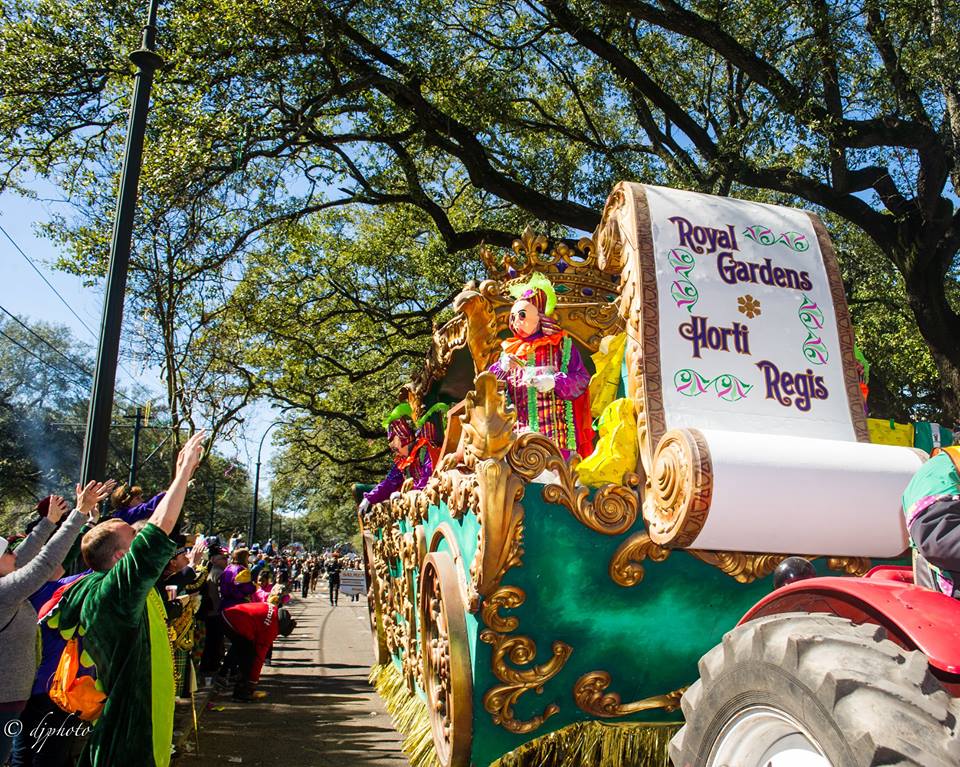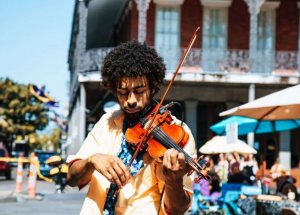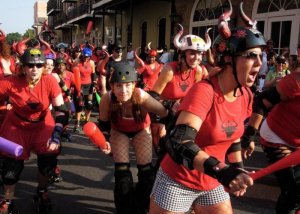Mardi Gras Parade Schedule 2020
Note: We will update this post for 2024 as it gets closer to the Mardi Gras 2024 season.
For the best views in the city, consider purchasing grandstand tickets to this year’s parades from New Orleans Parade Tickets.

One of the best parties in the world is here! The Carnival season kicks on Twelfth Night or the Epiphany, with three parades. It will culminate as usual on Mardi Gras Day, which this year falls on February 25, 2020.
Here’s the rundown of this year’s parades that will roll in February and through Fat Tuesday in the city of New Orleans.
Saturday, February 1, 2020
Intergalactic Krewe of Chewbacchus, 7:00 PM (Bywater, Marigny)
The Intergalactic Krewe of Chewbacchus will walk-n-roll with yet another sci-fi theme and the usual menagerie of the mythical creatures, space monsters, movie characters, and lots and lots of Princess Leias. The krewe hasn’t capped the membership, at least not yet, so expect a long procession of walking sub-krewes (there are over 150 to date with over 1,000 members) with out-of-this-world floats and other creatively decorated contraptions that include bikes, trailers, and even shopping carts. The krewe eschews using petroleum products, preferring greener methods to power their floats. Most throws are also handmade, including the custom bead medallions, stuffed animals, and the Sacred Drunken Wookiee stickers. Chewbacchus starts and ends in the Bywater, on Press and Chartres streets, spending the bulk of the parade walking down the 11 blocks of St. Claude Avenue.
Friday, February 7, 2020
Krewe Bohème, 7 PM (Bywater, Marigny, French Quarter)
This new marching parade, started in 2019, rolls though the Bywater, Marigny and French Quarter, led by a Green Absinthe Fairy (in place of the usual king and queen) and followed by several inner krewe marching clubs, including Krewe of Goddesses, the Merry Antoinettes, the Bayou Babes, and Glambeaux.
Saturday, February 8, 2020
Krewe du Vieux, followed by Krewedelusion, 6:30 PM (Marigny, French Quarter)
Note: These parades may not be suitable for children.
Krewe du Vieux (KDV) is infamous for its biting political satire, adult themes and irreverent takes on the city’s daily struggles. Its 17 sub-krewes are mostly the walking kind, interspersed with the small-scale floats and some of the best brass bands in the city. KDV rolls in the Marigny and the French Quarter and has some of the carnival’s most creative handmade throws.
The relative newcomer krewedelusion follows KDV along the same route starting at 7 PM. This satirical parade krewe is comprised of “inner krewes” including the Guise of Fawkes, Krewe Dat 504 and Krewe du Seuss. The krewe’s slogan is “The People Shall Rule — Until a Suitable Replacement Can Be Found.” The theme is kept secret till the day of the parade. The new-ish inner krewe, The Trashformers, will collect unwanted beads, cans, plastic cups and other parade debris in the attempt to reduce the parade’s already pretty small carbon footprint.
Sunday, February 9, 2020
‘tit Rəx, 4:30 PM (Bywater, Marigny)
This micro-krewe parade is unique in a way that it takes an opposite approach to the super krewes competing to set records for the extravagance as well as the number of floats, riders and throws. Instead, this walking parade capped its float number years ago and focuses on all things small-scale.
All floats (around 35) have shoeboxes as their base, similar in concept to what the local kids make for school projects, but to a much more advanced degree of artistry. There were elaborate double-deckers in the past years, as well as puppets and even a helium balloon-powered float. The floats are hand-pulled by about 120 unmasked, formally dressed members. All throws are handmade and tend to be miniature in size (the bead throws, for example, are usually the size of a bracelet or smaller).
Over the years, the parade had acquired a loyal following, with the spectators setting up miniature scenes of dolls partying on ladders along the route. The parade is generally kid-friendly, although there’s an occasional raunchy take on the theme, and always a lot of political satire. The parade rolls in the Bywater and the Marigny, starting by the St. Roch Tavern and ending at the AllWays Lounge for the annual ball.
Friday, February 14, 2020
Krewe of Cork, 3:00 PM (French Quarter)
Oshun, followed by Cleopatra, Alla, 6:00 PM (Uptown)
The Krewe of Cork is a spirited walking parade contained to the French Quarter and dedicated, as you probably guessed, to wine and revelry. Krewe members don wine-themed costumes and dole out throws bearing the krewe’s grape logo. The “wine police” rides along in golf carts, and the parade’s Grand Marshal is a different vintner ever year.
The Krewe of Oshun is named for the Yoruba goddess of love and has 20 floats, led by the captain aboard a peacock float down the traditional Uptown parade route. The Baby Dolls march along, and throws include peacock figures and mugs.
Another Uptown parade on that day, the all-female Krewe of Cleopatra has 1,000 members and stunning floats. The Queen of the parade travels in her royal barge, and the parade is flanked by the pre- and post- celebration extravaganzas.
For over 80 years, the Krewe of Alla was all-male but now one of the city’s oldest parades is co-ed. Founded in Algiers in 1932, the krewe now parades Uptown. It’s also moved to a different day in 2020.
Saturday, February 15, 2020
Pontchartrain, followed by Choctaw and Freret, 1:00 PM (Uptown)
Sparta, followed by Pygmalion, 5:30 PM (Uptown)
Things will be heating up on that Saturday with no less than five parades, all rolling Uptown and starting with the memorable floats of Krewe of Pontchartrain, including a huge crawfish named Mr. Mudbug and the giant fish named The Super Grouper. The co-ed Krewe of Freret, resurrected in 2011 since the mid-1990s thanks to some enthusiastic Loyola alumni, will again feature hand-decorated masks the members create themselves.
The Knights of Sparta, an all-male krewe, is known for the elaborate masks and Spartan helmets. Look for out for the medallion beads, doubloons, and the annual mystery throw. Post-parade, the party goes on at the Pygmalion Fest at Generations Hall.
Sunday, February 16, 2020
Femme Fatale, followed by Carrollton, King Arthur, 11:00 AM (Uptown)
Barkus, 2:00 PM (French Quarter)
Come catch Mystic Krewe of Femme Fatale‘s signature throw, a mirrored compact, along with the 2020 theme bead, Femme dolls, stuffed lips, and lipsticks. The Krewe of Carrollton is the fourth oldest Carnival parading organization, behind Rex, Proteus, and Zulu. Special throws include medallion beads and decorated shrimp boots.
The 50-plus float King Arthur parade featured the krewe’s first ever three-tandem float in 2019. Throws include hand-decorated grails, King and Queen medallion beads, and the King Arthur Toy Army.
The Mystic Krewe of Barkus belongs to the man’s best friend, with a focus on the seemingly endless procession of costume-clad, mostly well-behaved dogs escorted by their humans. The king and queen are, naturally, canine.
Wednesday, February 19, 2020
Druids, followed by Nyx, 6:30 PM (Uptown)
The Krewe of Druids pay homage to the priests of ancient Celtic societies and is led by the king, the Archdruid. It’s a unique parade in a way that its 200 members belong to other Carnival organizations, so it’s a parade-only krewe. Member identities are never revealed, and the krewe doesn’t have the traditional royalty.
The Mystic Krewe of Nyx is one of the city’s largest all-women’s Mardi Gras krewes and most diverse. The parade’s signature colors are hot pink and black, and you might be lucky enough to catch the signature throw, a hand-decorated purse. Past Nyx Goddesses includes New Orleans’ notable women like Chef Susan Spicer, Peggy Lee and Irma Thomas, the Soul Queen of New Orleans.
Thursday, February 20, 2020
Parades cancelled
Friday, February 21, 2020
Krewe of Bosom Buddies, 11:30 AM
The Krewe of Bosom Buddies & Breast Friends is a walking krewe that parades in the French Quarter on the Friday before Mardi Gras. The parade starts and ends on Bourbon St., and the krewe is usually dressed in tutus, bras and hats that reflect that year’s theme. The signature throw is a hand-decorated bra. The parade is raucous fun for sure, so we won’t call it 100 percent kid-friendly. Starting at noon, also on Bourbon Street, the all-female walking Krewe of Crescent City Dames will also hit the French Quarter. This krewe’s signature item is an elaborately beaded corset.
Muses, Knights of Babylon, 4:45 PM (Uptown)
The Knights of Babylon goes back to 1939 and honor the Carnival traditions by using the flambeaux and the floats with the same designs as decades ago. The king’s float is still drawn by a mule. Babylon’s 200 knights are led by their king, Sargon, whose identity is not revealed to the public. Babylon’s theme is also kept secret till the day of the parade. Similarly, the satirical Chaos also doesn’t reveal the king’s identity or the parade theme ahead of time. The all-male krewe counts 200 members.
The Krewe of Muses is one of the Carnival’s most popular parades thanks to its dazzling floats, top-notch marching bands, and bitingly humorous themes. The cup throw bears the design of the annual contest winner among the local school children. The winner also gets to ride as a guest of the krewe. Look for the iconic shoe float with this year’s honorary muse (usually a celebrity), and see if you can catch one of the most coveted throws of the Carnival season, the hand-decorated Muses shoe. Each shoe is a one-of-a-kind piece of art, and some parade-goers would stop at very little to score one.
Hermes, followed by d’Etat and Morpheus, 5:30 PM (Uptown)
The Knights of Hermes has been around since the Great Depression and was one of the first parades to mobilize after Katrina. About 700 male riders are led by their captain clad in full regalia and riding white horse.
The satirical Le Krewe d’Etat traditionally follows Hermes with 21 floats plus its Captain and officers on horseback. The theme is secret until parade day. Look for members of the krewe dressed as walking skeletons handing out the D’Etat Gazette and wooden doubloons. The Gazette has illustrations and descriptions of the floats and is only available during the parade. Another covetable throw is the blinking logo skull bead.
The Krewe of Morpheus parade is a jaw-dropping spectacle with about 500 riders and beautifully illuminated floats.
Saturday, February 22, 2020
Iris, followed by Tucks, 11:00 AM (Uptown)
Endymion, 4:15 PM (Mid-City, Downtown)
Amazingly, the Krewe of Iris has been around since 1917, making it the oldest female Carnival organization for women. Iris’ 1,500 members wear white gloves and masks, and the parade features such unique throws as king cake babies and hand-decorated sunglasses. The Krewe of Tucks was started in 1969 by a group of Loyola students and is named after of the now-gone Uptown pub. Tucks is known for satirical floats and irreverence (one of the signature floats, for example, is a giant toilet).
These days Krewe of Endymion is the only super krewe parade that graces Mid-City, and people camp out for days in advance staking their spots. While we won’t comment on that, we certainly understand the reasons for the parade’s immense popularity. With a whopping 3,100 riders and 37 floats (many are tandem units with up to nine sections!), plus celebrity guests and the big-name bands, Endymion is an amazing spectacle. It also helps that the riders are notoriously generous with beads (the krewe’s motto is “Throw ’til It Hurts”), and the event kicks off at noon with a huge block party on Orleans Avenue, Samedi Gras. Starting in 2019, the floats were pulled by new tractors with automatic transmissions, to reduce the lurching. From Mid-City the parade makes its way to Lee Circle, ending up at the Champions Square and finally inside the Superdome for some serious partying at the Endymion Extravaganza.
Sunday, February 23, 2020
Okeanos, followed by Mid-City and Thoth, 11:00 AM (Uptown)
Bacchus, 5 PM
Founded in 1949, the Krewe of Okeanos was originally a neighborhood parade on St. Claude Avenue but eventually moved to a traditional Uptown/Downtown route on St. Charles Avenue. Okeanos has about 250 riders. Notably, instead of the traditional bal masque the krewe hosts a coronation ball where the king is presented and the queen is selected by random draw.
The Krewe of Mid-City also dates back a while, to 1933, and consists of 300 all-male members. The parade has a unique look featuring tinfoil as well as animation, and is known to rock themes irresistible to children. The king and queen are kids selected each year from the local Ronald McDonald House.
Thoth, founded in 1947, had been following its own parade route designed to pass several healthcare institutions that care for people with disabilities and illnesses (thus bringing the Carnival to those who otherwise wouldn’t be likely to see the parades rolling elsewhere). The krewe is known to throw generously, and has 1,600 riders on its 50 floats. It’s one of the highlights of the Carnival.
Box of Wine is a walking parade that rolls between Thoth and Bacchus, whenever the police escort gives a green light, from a secret location that changes every year. It follows the Bacchus route but you won’t mistake it for any other Uptown parade. It is decidedly its own animal, in all its artsy, bohemian glory. Satire and the god of wine rule; and the joyful, rowdy procession of revelers clad in some of the most creative costumes you’ll see during the Carnival generously pours from boxes of wine the participants all carry for the onlookers lined up to see Bacchus — into the cups, or straight into the mouths.
The last treat of the Sunday before Mardi Gras is the unmatched super-krewe parade, Bacchus. Bacchus was the first parade to invite a celebrity king to lead the parade, breaking with the Carnival tradition. Expect spectacular animated super-floats and covetable throws. Look for the Bacchus’ signature floats like its Kong Family and the Baccha-gator. The massive parade ends at the Convention Center for its annual black-tie Rendezvous party.
Monday, February 24, 2020 (Lundi Gras)
Proteus, followed by Orpheus, 5:15 PM (Uptown)
Red Beans/Dead Beans, 2 PM (Marigny/Bayou St. John, Tremé)
The Krewe of Proteus is the second-oldest krewe in Carnival history, founded in 1882. Unbelievably, the floats still use the original chassis. The identity of the king of the parade is never revealed to the public. The kings traditionally ride in a giant seashell float; throws include pearl bead necklaces and plastic tridents.
Krewe of Orpheus was co-founded by musician/actor Harry Connick, Jr. and his father, Harry Connick, Sr., former New Orleans district attorney. It was the first super krewe to include both male and female riders, and it’s considered one of the most beautiful parades of the season.
The floats are elaborately designed and decorated with oversized flowers and fiber optic lighting. Covetable throws include light-up medallion beads and stuffed dragons. Like Bacchus, Orpheus ends at the Convention Center for its black-tie ball, and invites celebrities to reign as parade royalty.
A family-friendly, quirky Red Beans parade of revelers clad in costumes that are decorated with (and sometimes, made of) dried red beans started in 2008 and traditionally rolls on Lundi Gras. There’s also a slew of outfits that celebrate Louisiana folklore and food. This highly participatory walking parade of about 150 members winds from the Marigny into the Tremé, where it meets up with the newcomer Dead Beans. Formed in 2018 as a Red Beans spin-off, Dead Beans walks from the Bayou St. John neighborhood in Mid-City.
Tuesday, February 25, 2020
Parades: Zulu, 8:00 AM (Uptown, Tremé)
Rex, followed by Elks, and Crescent City, 10 AM (Uptown)
Society of St. Ann/Society of St. Cecilia, 9 AM (Bywater/Marigny/French Quarter)
The Krewe of Zulu parade begins bright and early on Mardi Gras Day at S. Claiborne and Jackson avenues, weaving its way down St. Charles Avenue to Lee Circle, then to Canal Street, and ending up at Broad and Orleans streets. It’s probably best to watch it towards the end of the parade, in Tremé. Wherever you end up, however, Zulu is not to be missed. One of the oldest Carnival parades in the city, Zulu dates back to the early 1900s. Louis Armstrong reigned as its King in 1949.
Zulu’s traditional honor guard, the Soulful Warriors, has a roster of characters that make an appearance each year, including Big Shot, Witch Doctor, Ambassador, Mayor, Province Prince, Governor, and Mr. Big Stuff. One of the most covetable throws of the Carnival is Zulu’s hand-painted, glitzed up coconut. The parade is preceded by the coronation ball on Friday, February 21, 2020, at the Convention Center.
Rex, the King of Carnival, is the mothership of many Mardi Gras traditions, like doubloon throws and even the official Carnival colors of purple, green and gold. The parade was founded in 1872, apparently to impress the visiting Grand Duke Alexei Alexandrovich of Russia. Today the parade traditionally follows Zulu on Fat Tuesday, and consists of 600 male riders. The king’s identity is kept secret until Lundi Gras, and it’s usually a civic leader and important citizen of New Orleans. Traditionally, the city mayor hands Rex a symbolic key to the city on Lundi Gras, and Rex royalty meets the Zulu royalty.
The Krewe of Elks-Orleans, the oldest and largest of all the truck float krewes, follows Rex down St. Charles Ave with 50 individually designed truck floats carrying 4,600 male and female riders. The last parade of the Carnival, the Krewe of Crescent City, is also a truck parade. It follows Elks, signaling the beginning of the end of the Carnival.
If you want to see some very impressive costumes look for the Society of St Anne walking parade. The members gather in the Bywater around Piety St. and Burgundy St., and usually roll around 9 AM or so, through the Marigny and the Quarter to the Mississippi River, with many stops on the way. The route isn’t set in stone but you can look for them around 10 AM in the Marigny by Mimi’s; the R Bar, also in the Marigny, is also a regular stop at a later time.
Since the parade’s inception in the late 1960s the members would pay tribute to those who had passed away in the preceding year at the river, by depositing their ashes in the water, making offerings, and so on.
Along the lines of the St. Anne Society, the Society of St. Cecilia, which started marching in 2007, also walks from the Bywater around the same time to the river. The two processions inevitably merge at some point, then scatter, and are organically joined by the fellow revelers. Both parades are a fabulous sight and are among some of the best things about Mardi Gras in New Orleans.
Are you coming to New Orleans for the Carnival? Browse our top recommendations for the historic hotels in the French Quarter at FrenchQuarter.com/hotels to find your perfect spot.
Happy Mardi Gras!






